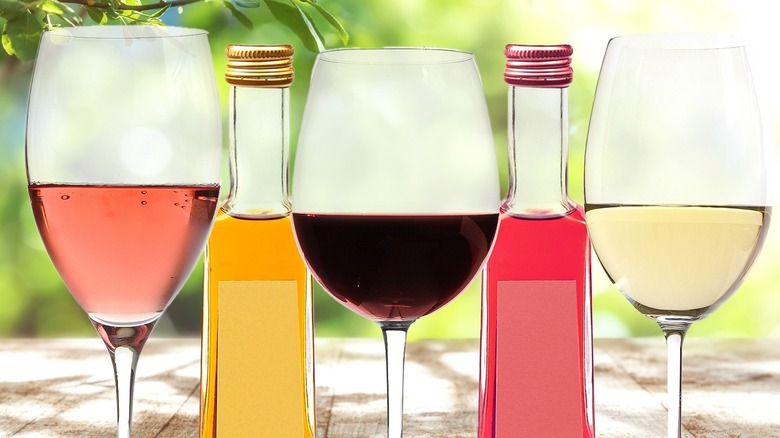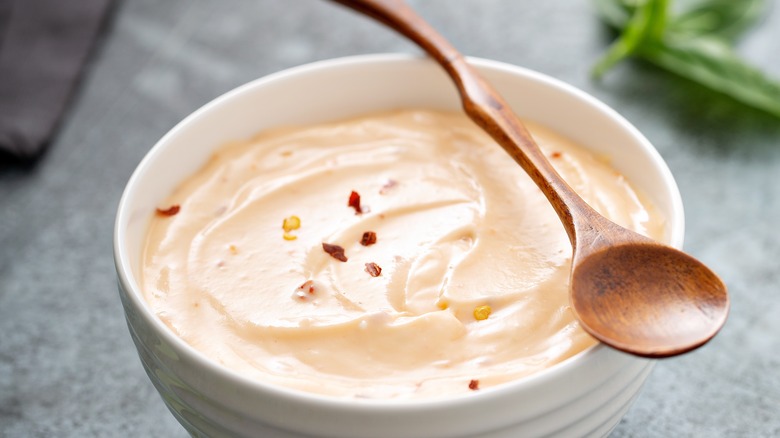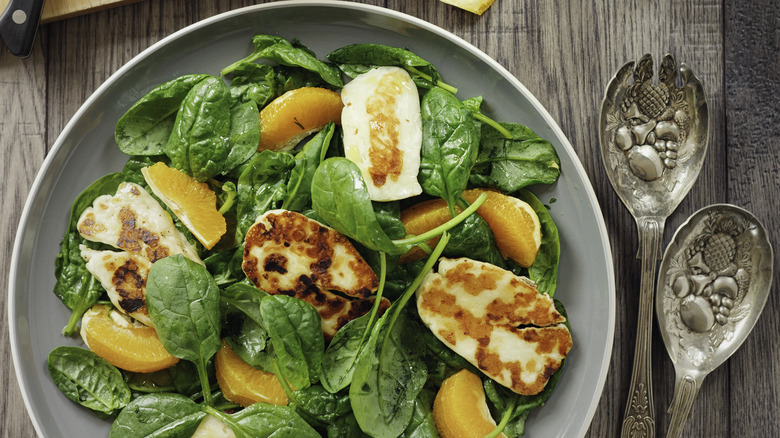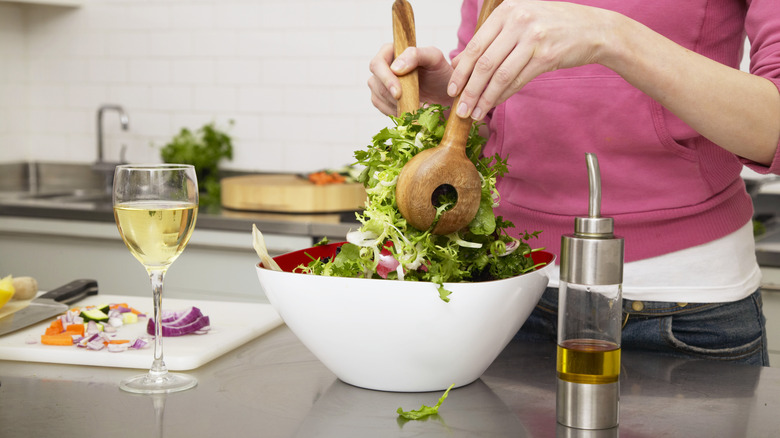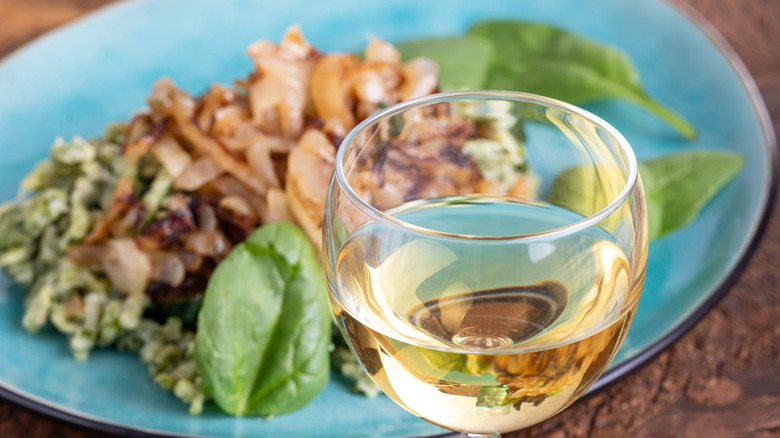When Picking A Wine To Drink With Salad, Consider The Dressing First
Once patio weather rolls around, it's hard to beat the appeal of a fresh salad. When done with care, the dish bursts with delicious textures, bright flavors, and enticing combinations. It's the kind of food that gets the meal off to a mouthwatering start — so what better way to enjoy than alongside a tasty wine?
Pairing a bottle with a salad can be surprisingly tricky; not only do the food's flavors lean acidic but there's also no classic protein combination to use as a launching point. As a result, consider the dressing when selecting a wine. After all, it's the central condiment that ties the dish together, defining both the dominant flavor and texture.
Fortunately, there are many types of salad dressings, so the potential wine-salad combo list is expansive. You'll just want to match a wine that's an equally flavorful counterpart — whether it's a Riesling that complements the sweet notes in a honey balsamic dressing or the bright acidity of sauvignon blanc alongside apple cider vinaigrette. In addition to the many recommendations, don't feel intimidated to experiment, too. Even if it's not a perfect synergy, you'll still be left with a delicious salad and wine for dinner.
Pair creamy dressings with similarly buttery wines
Creamy salad dressings soften greens with a delightful, gentle, and easygoing tang. They're typically composed of fatty bases that are either dairy-based or aioli — think yogurt, sour cream, or mayonnaise. Many, like this simple German salad dressing, ditch oil entirely, relying only on cream for its fatty component. Other familiar favorites like Thousand Island or Russian dressing might integrate some onions or horseradish for a bit of a bite.
Regardless of their flavor skew, these kinds of salads coat the mouth with richness, so reach for white wines with a similarly buttery mouthfeel. Chardonnay, as well as other wines that have undergone malolactic fermentation, are a perfect fit. Their tanginess is toned down through bacterial introduction and then further smoothed through oak aging. Other delicious examples include chablis, which is also made in the same Burgundy region, as well as meursault, which has a complex palate of nutty and floral notes.
However, no need to rely exclusively on Old World European wines for a buttery note. Such a quality is also apparent in Californian and Chilean chardonnays, which are typically aged in oak — another vessel for such a texture. This lends to a broad range of potential palates, with the ability to meld tasting notes per the exact dressing style. Plus, many of the wines produced in this style are affordable, making this one of the most stress-free combinations.
Citrus dressings shine with lightly acidic wines
A citrus-forward salad dressing is a wonderful summertime option, elevating greens through the tartness of fruit. Perhaps it's a classic lemon vinaigrette over lettuce or a more Levantine riff integrating lemon tahini into a baked falafel salad. It can include other fruits, too; Martha Stewart loves using yuzu in salad dressing, and a grapefruit vinaigrette brings a different shade of tart and bitter flavor to the mix. Regardless of the variety, freshly squeezed juice invigorates salads with a composed acidity that'll really pop alongside an equally zesty wine.
There's no need to go obscure for such accompaniment; reliable Pinot Grigio offers tart notes that are a perfect pairing. It's not an overbearing wine — its short finish won't drown out the bright citrus notes — but its acidity will still keep up. And you can reach for either an affordable Italian bottle or try out a more elegant offering from Oregon's Willamette Walley. The wine's broad range of production and price makes it an enticing pairing.
Spain's Albariño is another terrific option; a medium-bodied white with a bouquet of fruit, mineral, and crisp flavors to match a bright dressing. The wine has a nice bite, so pair it with an especially zippy citrus vinaigrette. And if you're after something drier, opt for Portuguese vinho verde, which comes in delightfully easy-drinking form. There are many wine options to serve alongside the balanced acidity of fruit, so whip up this dressing style to try out some interesting wines.
Pair the wide range of vinaigrettes with sauvignon blancs
Constructed on a foundation of oil and vinegar, the vinaigrette style is one of the most encompassing dressing types. This emulsion can integrate herbs and spices, crafting dressings like a smoked paprika or roasted tomato vinaigrette, as well as more straightforward riffs with different vinegar types. When pairing with wine, it's all about considering the dressing's acid content — which, due to the inclusion of vinegar, can get pretty acidic. As a result, you'll need an extra-tart vino that can match the sauce's puckery nature.
Across the board, the grassy, floral, and tangy nature of Sauvignon Blanc makes for an excellent choice. The wine's expansive area of production enables vinaigrette dressings. Say you're crafting a salad with the classic Italian dressing, which typically comes with a white wine base alongside numerous herbs — you'll want a New Zealand bottle to keep up with the bold flavors.
Alternatively, perhaps you're in the mood for a French dressing, which adds Dijon mustard and sugar for a slightly less zippy take. Then, reach for a California Sauvignon Blanc, which tends to be cleaner and a little less acidic. And if you're after a more bright mineral wine flavor — say alongside a citrus and vinegar vinaigrette — then go for a bottle from the Loire Valley, where Sauvignon Blanc originated. That's the beauty of this wine type; there'll be an exemplar with a tartness to match a range of vinaigrette creations.
Herb dressings go well with tart red wines
White wines are often the more obvious dressing pairing, but that doesn't mean they're the only option. Typically, red wines — especially ones high in tannins — aren't a great accompaniment to dressings since the acidity will make their palate off-putting. However, that's not a steadfast rule: very herb-heavy dressings will shine alongside flavorful reds.
Italian red wines — which pack both tannins and acidity — are a good candidate here. Go for Sangiovese, which goes great alongside oregano or sage-packed dressings. Its bold nature will synergize with equally aromatic salads. So pour a glass alongside dishes like a winter Greek salad, which goes heavy on the dark greens and oregano.
Another tasty wine option is Nebbiolo, which has a palate with more dark fruit and leathery notes, in addition to an herbal essence of its own. It's a beautiful selection alongside dressings that lean pungent, like a rosemary base or a parsley and garlic combination. And for another bold sip, consider Montepulciano, which has a rustic character that can match an aromatic spring salad with ramps and herbs. Such wines will deliver a bold flavor equivalent to their herbal dressing counterpart.
Serve a Riesling alongside sweet dressings
Consider dressings like honey Dijon, a particularly thick balsamic reduction, or a honey-based Asian dressing. While all constituted from different components, these sauces are united by their sugar-heavy palate, which lends them similar wine pairing qualities. As a result, you'll want an accordingly sweet yet complex bottle to match, which makes Riesling a great call.
This wine is full of ripe fruit flavors, which can lean into spice and honey notes for certain varieties. It's a complex palate that varies per producer, sourced region, harvest time, and vintage, lending to expansive pairing potential. For example, take Spätlese — a German denomination that refers to Rieslings made from a late harvest. Especially when crafted in a sweeter style, they have a rich flavor and dense body, making them a wine that can match an Asian-style vinaigrette, which comes with sugar and bold flavors.
Alternatively, Rieslings can accompany more floral, fruity flavors — like in a honey-heavy dressing or a vinaigrette made with jam. Turn to Rieslings from Australia and New Zealand, which have a brighter, more citrus-like palate that melds alongside such salads. And if you're cooking with a particularly syrupy ingredient — like Bobby Flay's secret pomegranate molasses hack — you can even serve a Riesling crafted in dessert wine style, like a Beerenauslese or Eiswein.
Caesar salad opens to varied wine pairings
Few salads are more iconic than the Caesar, which can be interpreted in a wide array of forms. Depending on your exact preparation — with the dressing a way to elevate the Caesar's flavor — you'll be granted numerous pairing options.
Say your salad leans heavy on the anchovy — a traditional take with a fishy, savory taste. Then, treat the pairing as if it's a seafood meal. A super crisp Greek white like assyrtiko is an ideal choice. Typically produced on an island, the wine has a marine predisposition with a bright and mineral character. In Greece, it's often served with fried fish, which means it'll also mingle with the parmesan and crouton salad topping.
If your Caesar includes chicken or eggs, turn to a wine with body. Even if the dressing is tart and creamy, a light wine like Sauvignon Blanc will get drowned out by the protein. However, something like Grüner presents a great option: its vegetal notes play with the salad, but there's still enough boldness to balance. And if you're making a casual and classic take on Caesar, look no further than a medium-bodied Rosé. The wine's tart and lightly sweet palate is easy to love, just like the salad itself. It's a showcase that wine and salad dressings can be the occasion to break out some new bottles or sip on some old favorites — it's having an enjoyable meal that counts.
